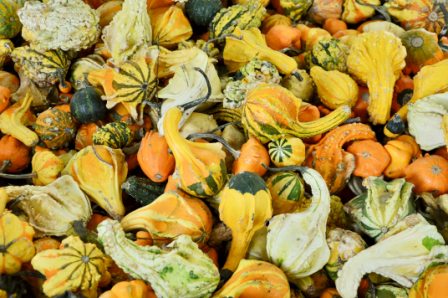
Gourds are an interesting crop to grow in your garden. The plants need no special pampering and the gourds are decorative on their own or in craft projects.
There are two types of gourds. The small, oddly-shaped, colorful gourds often seen in Autumn decorations are soft-skinned varieties of the Cucurbita family. These little gourds can be dried and saved, although their bright colors tend to fade over time. The larger, hard-skinned gourds are in the Lagenaria family, which include Birdhouse and Bottle gourds, among others. Lagenaria gourds are green on the vine and become tan or brown as they dry. Lagenaria gourd vines produce white blossoms which bloom at night.
It’s very easy to grow gourds, making them a good choice for beginning gardeners. Gourds prefer well-drained soil and they grow vigorously if compost is added to the soil when planting. Like other vining plants, gourds will appreciate a fence or other vertical surface to climb, but they’ll happily sprawl on the ground as well.
Gourds that are to be dried should be harvested very late in the season, after the vines have died back. Gently wash the gourds to remove any caked soil, and then dip them into a solution of 1-2 cups of bleach in a 5-gallon bucket of water. Make sure to handle the gourds carefully to avoid bruising them. Then place the washed gourds in an area where they will receive good air circulation. Some folks hang their gourds with a string attached to the stem. The drying gourds can be kept outdoors; rain or freezing temperatures won’t hurt mature gourds.
Check your drying gourds each week and discard any that have soft spots. No matter how careful you are with your gourds, some of them are going to rot. While they are drying and curing, gourds may also develop mold on their skins. The presence of mold indicates that moisture is escaping through the skin, which is a good thing. Unless the gourd is soft and mushy, the mold is not harmful and will leave a lovely pattern on the dried gourd.
It can take up to 6 months to completely dry gourds. When the gourds become lightweight and hard and you can hear the seeds rattle inside, they are ready for use.
I’ve dried gourds indoors, and in a well-ventilated and unheated barn, and left them on the vine all winter where they were covered with snow for months. Those that dried the best for me were the gourds that lay neglected in the garden all winter. It doesn’t get any easier than that.
Mike McGroarty is the owner of McGroarty Enterprises and the author of several books. You can visit his website at Freeplants.com and read his blog at Mikesbackyardnursery.com.
Related Articles & Free Email Newsletter
Growing Healthy, Productive and Profitable Plants through Succession Planting
Plant Propagation Calendar – What You Should Be Doing Each Month of the Year



Comment here